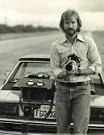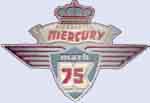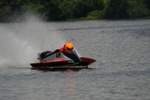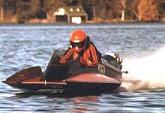As promised: If any who have read Wayne Baldwins "Master Oil Racing Team" thread entiltled "an Amazing Story" about racing with the four cylinder VC model Konigs in the 70's, are interested in the device that Ray Hardy came up with to improve drivability and acceleration, this narrative will give some insight to the idea and development of it and how it all came about. You may also want to look at pages 34,35,36,and 37 of the above mentioned thread for further information and background as to the reasons for the fabrication of the device. The "gadget" was primarily developed to overcome the fact that the "ZAK STACKS" that Harry Pasturczak came up with in the late 60's, and did not slide, were put at a disadvantage when the Konig's came with sliding pipes and the later design that improved them even more by changing the casting of the block to move the exhaust ports closer together. This basically obsoleted Harry's pipes as the elbows which were castings would not fit the port spacing anymore on the newer block design. Harry felt it was too much trouble to make new patterns, along with the issue that the design he was using that dumped both cylinders that fired together into the same chamber (which was opposite from the way Konig was doing it) was much more difficult to have the pipes slide on than the fabricated "Y" type manifold that came on the motor from the Konig factory. He did make some attempts to overcome this and some pictures and a description of how they worked are on the thread previously mentioned. The device was only used by a few racers in that time period, primarily ones that Ray Hardy had a close personal relationship with, and the few that had it were all sworn to secrecy not to divulge any details about it or the fact it was being used. Even now, more than 30 years after the fact, the number of people who seem to have either had one he made, or may have known about it, probably is less than 10 to the best of our knowledge at this time. It has been suggested that the details of the device be divulged so that anyone who now would wish to take advantage of the benefits of it would be able to do so. The original racers who had one have discussed this on this forum and otherwise, and it has been decided to give anyone interested the same basic information and ideas that I first gave Ray in the early 70's and see if the technical minded of you out there today are interested in trying to duuplicate or improve on the original idea and concept and possibly bring some of the old Konigs out of the basement, make the few that are still on the water more competitive, or even adapt the idea to the Konney motor, the new generation of Konig type design.
To the problem: The Konig design with the external rotary valve was a very good design, and was top dog for a long time, but one thing that could have made it more competitive individually against others of the same type, or different engines that were equal in HP, would be the ability to adjust the rotary valve timing while the engine was operating. Depending on course length, configuration, etc., the timing of the rotary valve was a compromise. You either timed it for good or better bottom end and then the top end suffered some, or the other way round. Either way, what you gained on one end you lost on the other. Same way with the original "tin can" type muffler the motors came equipped with, you either tied it up close with the cable for top end, or left it back for acceleration. You could have one or the other but not the best of both. Because I was running ZAK pipes on my C and D konig at the time and was very competitive until about 74 or so when the guys with sliding pipes were starting to get me out of the corners, I was very interested in coming up with a way to "have my cake and eat it too".
As I was working with Harry ZAK very closely on both my engines, we were trying all sorts of things, including the differently cut rotary valve discs mentioned by Wayne on the other thread, but you still had to time it in one place and make do from there.
About this time frame I happened to read in some magazine, I believe a road racing bike publication, about some work that Rotax had done with an adjustable rotary valve. I don't remember now whether they were even successful with the project, but it got me thinking, what if? So I called Harry Zak and he said he was too busy with other projects right then, but maybe Ray would be interested in hearing the idea and could do something with it. Ray and I had been friends for a while at that time so I called him and told him about the concept and he was enthusiastic about it, especially when I mentioned how I thought it could be accomplished, namely the same way that ignition timing was changed on an automobile from low to high rpm, by mechanical means. He asked if I had an extra flywheel with the rotary valve gear on it and if so to send it to him. I did and about a week later, I got back the first prototype of the device, installed it, and went testing. It worked well enough that we definately could see potental there. I ran it at a couple of races, but the main problem was when it worked correctly, it worked very well and really broadened out the power band, making the boat quicker around the race course, but there was a problem that would occur at times with the device binding or sticking and you never knew where in the degree of travel you had that that might occur. If it was at the low end of the setting, then the same problem with the non-adjustable valve, lots of bottom end punch but no top end, or at least maybe 5MPH short of what you would normally have. Same thing if it hung on the top end side, no punch, and without the ability to slide Harry's pipes, you had a problem. Ray did a lot of work over the next several years on the device and it went thru about four generations, the last of which worked pretty well according to Wayne. I didn't have the opportunity to play with it past about 1976 as I had my hip replaced courtesy of a tunnel boat blow over and didn't race again myself until the early 80's after Eileen had retired from Formula 350.
What we learned was this: The device definately worked. The advantage of being able to have the rotary valve work in a degree range that provides both bottom end acceleration and possibly now, even more top end because of the more modern porting technology in the present day motors, would seem to be a project that would be worth someone taking on. The rewards could be very great.
The main problem with the device in the time frame it was developed seemed to be the bearing material availiable then not being able to withstand high RPM and galling somewhat, causing binding in the mechanism. It will be interesting to see if someone will take this idea and try to make it work again, 30 some odd years later.
The description of the device is purposely vague, as you will understand if you read the "Amazing Story" thread mentioned at the top of this narrative. All of us who knew Ray had great respect and affection for him, and even now want to respect his wishes about the "gadget" We also think though, he would be curious how someone else would approach the same problem and potental solution and have decided to put this very worthwhile solution to the problem of a rotary valve engine's main shortcoming in the public domain to see if and how it might be approached today.
If you have questions, feel free to ask. I can't promise we will answer you directly but I can guarantee you none of us that was privy to the secret will try to stand in your way or mislead you.


 Thanks:
Thanks:  Likes:
Likes: 


 Reply With Quote
Reply With Quote








 250 is more than fast enough for me these days
250 is more than fast enough for me these days 



Bookmarks